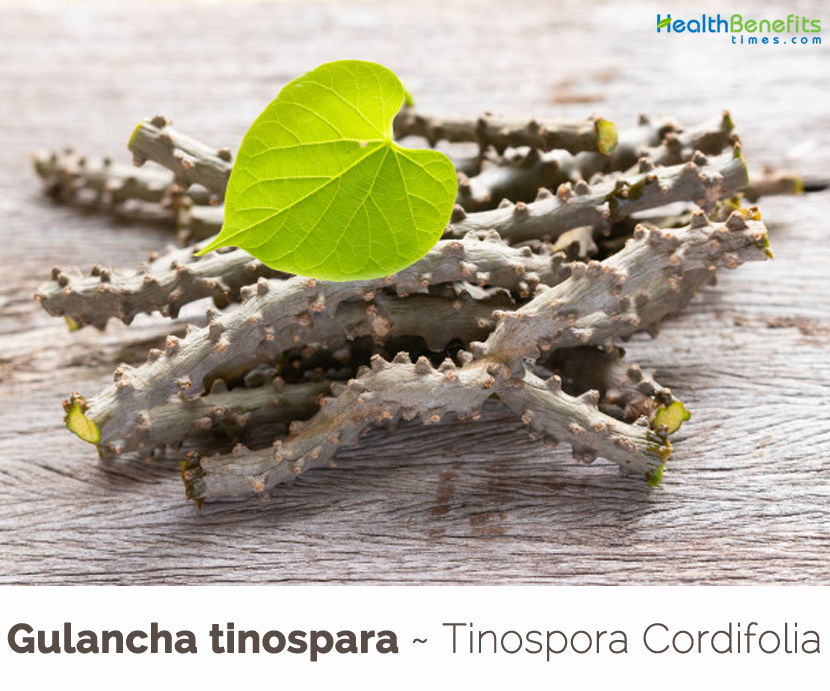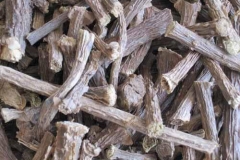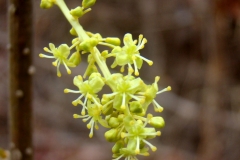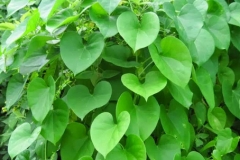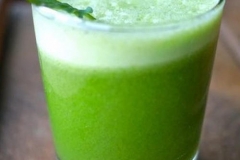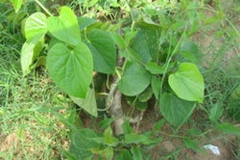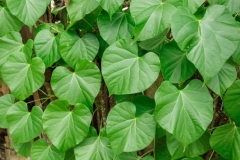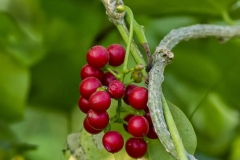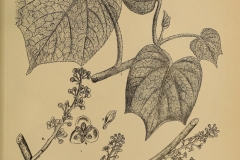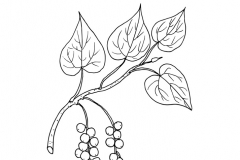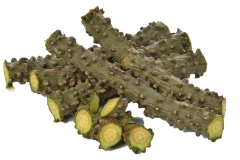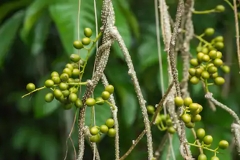It is known as queen of all herbs and is supposed to be the nectar of god Indra, that’s why, it is considered Amrita (pious liquid or nectar). It is used in the treatment and curing of many diseases and known as solution for all the diseases and disorders. Giloy is useful in the promotion and restoration of health and make you ready for holistic well-being. It is widely used as a unique ingredient of various natural medicine and traditionally use for numerous aliment like fever, vomiting, diabetes, jaundice, anaemia, polyuria and skin diseases etc.
Plant Description
Gulancha tinospora is a large, herbaceous, deciduous glabrous, succulent, climbing shrub that grows about 1.0 meters (3.3 feet) tall and 0.5 meters (1.65 feet) wide. The plant is typically found growing in deciduous and dry forests. It prefers light medium sandy loam soil rich in organic matter, and with adequate drainage. It does not tolerate high rainfall or waterlogged conditions. Young stem is green, cylindrical and smooth. The matured stem has warts on the surface, hanging aerial roots and peeling bark. Matured stem when crushed is sticky. Bark is gray or creamy white, deeply forked spirally and longitudinally, with large rosette-like lenticels. Wood is white, soft, and porous, and when freshly cut, quickly assumes a yellow tint.
Leaves
Leaves are simple, alternate, heart shaped, membranous, Juicy, broadly ovate, cordate or sub orbicular, 4 cm -17 cm long and 4.5 cm to 14 cm across, base cordate to sinuate, margin entire, apex deeply acuminate or cuspidate, chartaceous and thin. Leaves are green, glabrous above and paler glabrous with glandular papillose patches beneath. Strong basal veins are 5-7, impressed above and prominent beneath. Lateral veins are 2-3 pairs, vein lets are fine and close, and petiole is twisted, swollen near the base, pulvinate, glabrous, about 2-7 cm long.
Flower
Flowers are uni sexual, fascicled, yellow and pedicellate. Male flowers are slender, glabrous about 3-4 mm long, sepals 6, in 2 series, inner series larger, elliptic, concave, about 3-4 mm long, outer series smaller, about 1-1.5 mm long, free, imbricate, sub-elliptic, apex acute, petals 6, free, rhomboidal, obovate, lateral edges in-rolled, fleshy, stamens 6, free, filaments clavate, about 3 mm long, anthers loculed, sub-extrorse, obliquely or longitudinally dehisced. Female flowers have sepals and petals similar as in male flowers, staminodes 6, carpels 3, curved-ellipsoid, about 2 mm long, glabrous, style short, stigma capitate. Flowering normally takes place from May–June.
Fruits
Fertile flowers are followed drupes, ovoid or globose, glabrous, shining, about 5-7 mm across, stalks about 4-7 mm long, pericarp thin, style scar sub-terminal. Endocarp is bony, very thin, subrotund or broadly elliptic about 6-7 mm long, rounded, flattened ventral, slightly papillose on surface, style scars sub basal. The fruit is initially green turning to bright red when ripe. Fruits look like bunch of red cherries. Seeds are curved or half-moon shape, endospermic, cotyledons flattened, leaf-like, radicle short.
Health benefits of Gulancha tinospora
Gulancha tinospora’s delicate heart-shaped leaves, reminiscent of decorative plants, don’t reveal the full extent of its medicinal potential. But those in the know understand how powerful a remedy it can be. Tinospora cordifolia may hold the key to a host of diseases and health problems we face today. Here are the powerful benefits of Gulancha tinospara you should know
1. Skin diseases
When Gulancha tinospora is taken with ghee on empty stomach in the morning, it helps to cure all types of skin diseases including, acute & chronic dermatitis, prickly heat, sunburn, pruritus related with urticaria, all forms of cosmetic allergy, ringworm, psoriasis, leucoderma and leprosy.
2. Boosts digestion
Indigestion is a common problem. Gulancha tinospora can take care of the digestive system. Consuming half a gram of giloy powder with amla regularly can keep all digestive problems at bay. Having giloy juice with buttermilk will also be effective in this case. This remedy can also be used by patients suffering from piles.
3. Treats Arthritis
Gulancha tinospora (Giloy) consists of anti-inflammatory and anti-arthritic properties that help treat arthritis and its several symptoms. For joint pain, the powder from giloy stem can be boiled with milk and consumed. It can be used along with ginger to treat rheumatoid arthritis.
4. Boosts Immunity
Gulancha tinospora is a universal herb that helps boost immunity. It is a powerhouse of antioxidants which fight free-radicals, keep your cells healthy and get rid of diseases. It helps remove toxins, purifies blood, fights bacteria that causes diseases and also combats liver diseases and urinary tract infections. It is used by experts in treating heart related conditions, and is also found useful in treating infertility.
5. Prevent cancer
It encourages the propagation of stem cells and increases in total white blood cells and bone-marrow cells thus boost antibody-producing cells and phagocytic activities. Giloy extract proved beneficial in decreasing the chemo toxicity induced by free radical forming chemicals. Oral administrations of rasayanas along with other indigenous herbal drugs were found to protect from Cyclophosphamide.
6. Treats chronic fever
Gulancha tinospora helps to treats chronic fever and diseases. As it is anti-pyretic in nature, it can reduce signs and symptoms of several life-threatening conditions. It increases the count of your blood platelets and relieves symptoms of dengue fever as well. Giloy along with little bit of honey treats malaria.
7. Treats diabetes
Diabetes is worldwide diseases many people are suffering from. Giloy acts as a hypoglycemic agent so it will be effective for diabetic patients. It can lower the levels of blood sugar and lipids. This makes it very easy to treat type 2 diabetes. Patients with type 2 diabetes can consume giloy juice to in order to reduce high levels of blood sugar.
8. Heart disease
Giloy along with piper nigrum has positive impact on cardiac conditions such as angina pectoris, myocardial infarction, ischemic heart diseases and certain arrhythmias. It will help clear the obstruction in the arteries as well as in the heart and act as cardio-protective agent.
9. Treats urinary infections
Giloy is used to cure all type urinary infections such as uricouria, ketonuria, glycouria, haematuria, albuminuria, dysuria, crystaluria, burning micturition in cystitis, urethritis and particularly in diabetes mellitus.
10. Reduces anxiety and improves mental strength
Giloy is often combined with other herbs to make an excellent health tonic. It not only clears brain toxins but also boosts memory. It also helps you improve your attention span. In this fast paced world where cut-throat competition is the norm, mental stress and anxiety is common. Giloy can reduce both mental stress and anxiety.
11. Reduces Asthmatic Symptoms
Asthma causes chest tightness, shortness of breath, coughing, wheezing, etc. which makes it very difficult to treat such a condition. Chewing on giloy root or drinking giloy juice helps asthma patients and is often recommended by experts.
12. Treats eye disorders
Eyes are one of the most important parts of our body. Giloy can be used to treat eye disorders. It boosts clarity and helps you see better without spectacles. In some parts of India, people apply giloy on the eye lids regularly. Boil some giloy in water, let it cool and apply it on your eyelids .You will definitely see a change.
13. Reduces Signs of Aging
Giloy plant consists of anti-aging properties that help reduce dark spots, pimples, fine lines and wrinkles. It gives you flawless, glowing skin that you’ve always desired.
14. Pilonidal Sinus (PNS)
Pilonidal Sinus (PNS) is also called sacrococcygeal fistula and Pilonidal abscess or cyst. It occurs on or near natal cleft of the buttocks. In this condition, oil processed with Giloy Juice and Turmeric Paste is beneficial for removing skin debris, pus and dirt particles. It boosts the healing process of wound and treats Pilonidal sinus.
15. Protects Liver and Fights Jaundice and Hepatitis
Mix your Gulancha tinospora powder with aloe vera juice or wheatgrass juice to detox and power up. The plant extract has a hepato-protective effect and moderates liver function favorably. If you have a fatty liver, this could be a natural remedy for your problem. Guduchi has been known to help prevent scarring of the liver (fibrosis) and can even stimulate the regeneration of damaged liver tissue. It may also have a role to play in fighting jaundice or even hepatitis since it can detoxify your liver.
Traditional uses and benefits of Gulancha tinospora
- Juice from crushed leaves is slightly warmed and used as an ear wash to alleviate earaches.
- Thin slices of the plant are eaten regularly to stop vomiting of blood.
- Plant is used in making medicines to treat gas and bile problems, urinary tract infections, menstrual disorders, earaches, and phlegm imbalances.
- Plant can be mixed and boiled together with myinhkwar leaves to alleviate heart palpitations and anxiety.
- It is also used in the treatment of diarrhea, dysentery, fevers due to cold, indigestion, rheumatism, urinary disease, bronchitis, and infertility.
- Stem, root and whole plant are alterative, antidote, aphrodisiac, diuretic, febrifuge and tonic.
- Starch obtained from the stem and root of the plant is nutrient and is useful in the treatment of diarrhea and dysentery.
- Fresh plant is more effective than the dried.
- Watery extract, known as ‘Indian Quinine’ is a very effective treatment for fevers due to cold or indigestion.
- Plant is also commonly used in a variety of other complaints including rheumatism, urinary disease, general debility, bronchitis and infertility.
- Juice or powder of Giloy Stem is useful in treating various types of Cancers.
- It prevents the formation of Cancer cells and stops the further growth of already developed Cancer.
- Tinospora Cordifolia is a top herbal remedy in preventing Swine Flu.
- Tinospora Cordifolia revitalizes the tissues and boost up the Immunity.
- Regular intake of Giloy increases the count of White Blood Cells and allows the body in resisting diseases.
- It purifies the Blood, removes toxins and prevents from various skin diseases like acne, psoriasis and eczema.
- Its Anti-inflammatory effect is helpful in reducing Joint Pain and Swelling. It is advantageous in conditions like Arthritis, Gout and Osteoporosis.
- Anti-pyretic action is useful in lowering the body temperature. Thus, it cures Fever.
- It improves Sperm Motility and increases Sperm Count.
- Giloy is a cure for burning sensation in the feet.
- It improves concentration and alertness and enhances the memory.
- The Anti-diabetic property of Giloy regulates the level of glucose in a person.
- It improves the Liver strength and helps to expel toxins from the Liver. It can be taken with sugar to cure Liver diseases.
- It is beneficial for a person addicted to Alcohol and junk food.
- Giloy juice is useful in curing Asthma. To make the juice more effective mix it with Neem and Amla.
- It is beneficial in combating Dengue. Giloy along with Tulsi leaves increases the platelet count and fights Dengue.
- It provides relief from Urinary Disorders.
- If you have Kidney Stones, Giloy is the solution.
- It cures Chronic Cough.
- For maintaining overall health chew some Giloy leaves daily.
- Using giloy delays the time of ejaculation and thus it acts as aphrodisiacs.
- It is given to lactating mothers, who is experiencing lack of milk.
- Alcoholic people should take giloy on regular basis as it helps to vitalize the liver tissues thus safeguards the liver, kidney and heart.
- It is also used in the traditional medicinal system of Thailand for treatment of Diarrhea.
- Shade dried leaves are ground into powder and mixed with hot water and the mixture is taken orally in the treatment of diabetes by the people living in sacred groves in Cuddalore district of Tamilnadu, India.
- Smashed leaf and root is added to Brown sugar and taken orally at night after normal dinner as a potent aphrodisiac by the village folk of nature and Rajshahi district of Bangladesh.
- Powder of root and stem is used along with milk for the treatment of cancer.
- Oral administration of the juice of stem with honey can also be used for treatment of asthma.
- Inhabitants of Orissa use the warm juice of root of T. cordifolia orally for the treatment of fever.
- Muslim tribals of Rajouri, Jammu comprising Gujjar and Backwals used the plant in bone fracture.
- Paste or juice of T. cordifolia leaves and seed powder of Brassica campestris is applied locally in case of burning sensation.
- Powder of Haritaki, Amrita and Ajwain in equal quantity is administered orally, once daily early morning with salt for the treatment of cough.
- Paste of T. Cordifolia and 5 seeds of Piper nigrum is administered orally once daily in morning in leucorrhoea by the local women of Arjunpura Rajasthan.
- Inhabitants of U.P. take the juice of stem orally with honey for the treatment of Asthma.
- Decoction of stem is administered orally in case of skin disease by the people of Dehrabara Kolaras, Sivpuri District of M.P.
- Tribals of Bombay and its neighboring areas use T. cordifolia as drug in the treatment of fever, jaundice, chronic diarrhea and dysentery.
- Tribals of Khedbrahma region of North Gujarat use powdered root and stem bark of T. cordifolia with milk for the treatment of cancer, decoction of root is used for the cure of dysentery and diarrhea and decoction of old stems is chosen in the treatment of periodic fever.
- Decoction of stem is administered orally by the people of Jammu and Rajasthan for the treatment of fever.
- Juice or decoction of leaves is administered orally with honey in fever by the local people of Punjab.
- In Dahanu forest division of Maharashtra, the stem decoction is used with cold or hot water (about 3-4 gm.) in morning in an empty stomach as a tonic in general debility.
- Shirt of child is dyed in juice of Guduchi and worn in emaciation in children by the inhabitants of Bihar.
Ayurvedic Health benefits of Gulancha tinospora
- Anemia: Take the fresh whole Tinospora Cordifolia. Coarsely grind the herb and squeeze out the juice. Have 2 tablespoon of juice daily for a month and get your Red Blood Count tested.
- Leucorrhea: Taking Tinospora juice with Honey is useful to cure leucorrhoea.
- Allergy: Prepare Tinospora Cordifolia stem decoction. Drink 30 ml twice a day. OR Take half teaspoon of stem extract. It will reduce allergic symptoms such as sneezing, itching, and nasal discharge
- Gonorrhea: Extract the juice of Tinospora Cordifolia. Mix 5 ml in a cup of milk. Add sugar according to your taste. Drink it 3 times a day.
- Wounds: Take some Tinospora Cordifolia leaves. Warm them over low flame. Apply on the affected part.
- Migraine: Take 5 drops of Tinospora Cordifolia juice with one teaspoon of Honey daily.
- Diabetes: Extract the juice of Tinospora Cordifolia plant by crushing it. Drink 50 ml of it twice a day.
- Ulcers: Bake some leaves of Tinospora Cordifolia. Bandage it over Ulcers.
- Fever: Drink 15 ml decoction of Tinospora Cordifolia plant twice a day.
- HIV/AIDS: Regular intake of Tinospora Cordifolia plant juice helps in increasing the Immunity of the person.
- Rheumatoid Arthritis: Consume 20 ml plant juice of Tinospora Cordifolia twice a day. OR Take you can also take it with Ginger.
- High Cholesterol: Drink 10 ml root decoction of Tinospora Cordifolia twice a day.
- Peptic ulcer: Take 1 tsp stem extract of Tinospora Cordifolia once a day.
- Earache: Extract leaves juice of Tinospora Cordifolia by crushing them. Slightly warm it. Use it as an Ear Drop. It will reduce the pain.
- Dipsia: Consume Tinospora Cordifolia juice 3-4 times a day. This juice is easily available in the market.
- Arthritis: Tinospora Cordifolia can be used with Ghee.
- Gout: Massage the affected area with Tinospora Cordifolia powder mixed with Castor oil.
- Constipation: Take one teaspoon each of Tinospora Cordifolia powder and Jaggery. Consume it every night after dinner.
- Hepatitis: Grind fresh leaves of Tinospora Cordifolia to extract its juice. Mix this juice with a pinch of Rock Candy. Consume it.
- Itching: Prepare a decoction, made of Tinospora Cordifolia leaves, Azadirachta Indica leaves, Adhatoda Vasica leaves and one cup of water. Strain and drink it. It is effective in curing Itching.
- Acid Reflux: Extract the juice of Tinospora Cordifolia leaves by grinding and squeezing it. Mix it with Cumin seeds. Consume one tablespoon of it. It will provide relief from Burning sensation.
- Elephantiasis: Tinospora Cordifolia is anti-inflammatory in nature. Have 5 drops of tincture in a glass of water 2 times in a day. OR: It is also available in tablet form. Have 1 tablet every day.
- Bone Cancer: Have Tinospora Cordifolia tea every day. OR: Have 10 drops of tincture in a glass of water 2 times in a day.
- Indigestion: Grind Gulancha Tinospora stem and Ginger separately. Take one pinch of Tinospora Cordifolia stem powder and 2 pinch of Ginger powder and boil in a cup of water. Drink it.
- Joint Pain: Boil one pinch of Tinospora Cordifolia stem powder and 2 pinch of Ginger powder and boil in a cup of water. Have it once a day.
- Fever: Grind equal quantity of Ginger, Tinospora and Long Pepper together. Boil 2 pinches powder in a cup of water. Take it with Honey.
- Jaundice: Powder the Tinospora Cordifolia stem. Mix 2 pinches powder and one tablespoon Raisins in one cup water and boil. Add sugar according to your taste. Drink once a day.
- Flu: Grind stems part of Tinospora Cordifolia and Uraria picta in equal quantity. Add cinnamon to taste. Take One tablespoon with lukewarm water.
- High Blood Pressure: Take the powder of 3 table spoon Winter Cherry Stem, One and Half table spoon Sunflower Seeds, 1/4th tablespoon Tinospora Cardifolia, 4 tablespoon Sugar. Mix them together. Take two tablespoon with water twice a day.
- Itching: Make a paste of Tinospora leaves and leaves. Apply over the affected area.
- Hiccups: Make a paste of Tinospora Cordifolia and dry Ginger with water by taking both in equal quantity. Take half tablespoon with a cup of milk.
- Gout: Take equal quantity of Dried Ginger powder, Tinospora Cordifolia stem powder and Indian Gooseberry powder. Add Honey to make paste. Take half tsp of the mixture twice a day.
- Swine flu Repellent: Take 10 inches Long Branch of Tinospora Cordifolia and 7 to 8 fresh leaves of Basil. Boil in one liter of water together. Strain. You may add Black Pepper and Black Salt for taste. Have 2 tablespoons early in the morning. This mixture boosts immunity too.
- Swine Flu: Take 4 to 5 Basil Leaves, 2 Black Pepper, 3 to 4 Clove and 1 to 2 inch Tinospora Cordifolia. Boil in a glass of water for 2 minutes. Drink half cup daily.
- Gout: Take 50 grams each of Tinospora Cordifolia, Picrorrhiza Kurroa, Licorice and Ginger. Powder them together. Store in a glass bottle. Have a quarter teaspoon of this preparation with a teaspoon of Honey, once a day.
- Dengue and Chikungunya: Buy tincture of Night Jasmine, Tinospora Cordifolia and Yarrow from a Homeopathic shop. Give 10 drops of Night Jasmine (in some water) to start the treatment. After three hours give ten drops of Yarrow. After three hours give 10 drops of Tinospora Cordifolia. Keep repeating for the next three days. The fever should become normal within one day. However, the drop in fever must not be considered as a cure. The remedies should be continued for at least 3 days.
- Pancreatitis: Mix 1/2 teaspoon of Tinospora Cordifolia powder and 1/4 teaspoon of dried Ginger powder. Have it with warm water 2 times a day. Do this for 15 days. OR: Add 1/2 teaspoon of fresh Ginger juice in 3 to 4 teaspoons of fresh Tinospora Cordifolia juice. Mix well. Drink it an hour before meal for 2 weeks.
- Urinary Tract Infection: Grind or take the powder form of 5 to 6 gm. Tinospora Cordifolia, 4 to 5 gm. Ginger, 4 to 5 gm. Indian Gooseberry, 5 gm. Ashwagandha, 5 to 6 gm. Gokshura and 200 ml Water. Add powder form of all the ingredients in 200 ml of water, Boil it under mild fire and stir it continuously until it reduces to 50 to 60 ml. Stop boiling it and filter this mixture. Take 15 to 20 ml of this infusion and drink it twice a day two hours before food.
Serious side effects of Giloy
However, people often ignore the possibility of side effects of giloy. It is likely that extensive use of giloy for natural treatments of health problems may pose risk of some unwanted results. If you have been unaware of giloy side effects, here are some of the common harms of giloy use.
Low blood sugar
While giloy may be good for your health for numerous reasons, it can be equally damaging in certain case. People who have health problems related to blood sugar levels should totally avoid the herb as it can further affect the blood sugar levels. Giloy can considerably lower the blood sugar levels, often posing risk of health problems caused by low blood sugar levels. Always take giloy after consulting your doctor.
Bad for surgery
Giloy can have some unwanted side effects on the blood sugar levels; it can affect blood sugar levels during and after a surgery, increasing the risk of complications from the surgery. It is best to avoid giloy for few weeks before and after a scheduled surgery.
Leads to constipation
Although giloy is quite effective in treating digestive health problems, it can occasionally further upset your stomach, regardless of the form it is taken in, leading to constipation. Consult your doctor instantly if you experience constipation or stomach irritation soon after consuming giloy.
Promotes autoimmune disease symptoms
Giloy may occasionally over-stimulate the immune system, resulting in increase of frequency or severity or autoimmune disorder symptoms such as lupus, multiple sclerosis, and rheumatoid arthritis. People suffering from autoimmune disorders should avoid giloy completely.
References:
http://www.hear.org/pier/species/tinospora_cordifolia.htm
https://pfaf.org/user/Plant.aspx?LatinName=Tinospora+cordifolia
https://www.drugs.com/npp/tinospora.html
http://bioinfo.bisr.res.in/project/domap/plant_details.php?plantid=0122&bname=Tinospora%20cordifolia
http://www.theplantlist.org/tpl1.1/record/tro-20600675
https://en.wikipedia.org/wiki/Tinospora_cordifolia
https://indiabiodiversity.org/species/show/231352
http://www.thepharmajournal.com/archives/2016/vol5issue7/PartB/5-7-6-477.pdf
http://www.flowersofindia.net/catalog/slides/Gulbel.html
Comments
| Gulancha tinospara Quick Facts | |
|---|---|
| Name: | Gulancha tinospara |
| Scientific Name: | Tinospora Cordifolia |
| Origin | India, Myanmar, Burma and Sri Lanka |
| Colors | Initially green turning to bright red when ripe |
| Shapes | Drupes, ovoid or globose, glabrous, shining, about 5-7 mm across, stalks about 4-7 mm long |
| Taste | Nauseating bitter, astringent, sweet, pungent |
| Health benefits | Skin diseases, Boosts digestion, Treats Arthritis, Boosts Immunity,Prevent cancer, Treats chronic fever,Treats diabetes, Heart disease, Treats urinary infections, Reduces anxiety and improves mental strength, Reduces Asthmatic Symptoms, Treats eye disorders, Reduces Signs of Aging, Pilonidal Sinus (PNS), Protects Liver and Fights Jaundice and Hepatitis |
| Name | Gulancha tinospara |
|---|---|
| Scientific Name | Tinospora Cordifolia |
| Native | India, Myanmar, Burma and Sri Lanka |
| Common Names | Heart-leaved moonseed, Indian tinospora, gulancha tinospora, heart-leaved tinospora, moonseed, Amrita, Duyutige, Gado, Galo, Giloe, Giloya, Guduchi, Gulancha, Heartleaf moonseed, Teppatige, Tinofend, Amarlata, Bael tiga, Kanda amrta, Rasakinda, amariat, amarlata, ambarvel, amirtavalli, amritalata, amrithaballi, amrta, amrtavalli, amrulballi, amrutaballi, amruth, amrutoballi, amrytu, amudam, amutavalli, asasi, batindu, cañcivi, chakrangi, chinnodbhava, chinnodbhava, chittamrutu, comavalli, dhira |
| Name in Other Languages | Arabic: Sat gilo Assamese: Shaguni-lata, Geloi, Amar-lata, Hoguni-lot Bengali: Gulancha(গুলঞ্চ) Chinese: Xin ye qing niu dan (心叶青牛胆), Kaun jin teng English: Gulancha tinospora, Heart-leaved tinospora, Indian tinospora, Moonseed French: Guduchi, Tinofolin German: Guduchi-Kräutertee Gujarati: Galo (ગળો) Hindi: China (छिन्ना), chinnaruha (छिन्नरूहा), giloy (गिलोय), gudach (गुड़च), gulancha (गुलञ्च), gulbel (गुलबेल), gurch (गुर्च), jivanti (जीवन्ती), jivantika (जीवन्तिका), pittagni (पित्ताग्नी), tiktaparvan (तिक्तपार्वण), vajra (वज्रा) Kannada: Agniballi (ಅಗ್ನಿಬಳ್ಳಿ), Amrita balli, Amrutaballi (ಅಮ್ಱುತಬಳ್ಳಿ) Konkani: Amritvel (अमृतवेल) Malayalam: Amritavalli (അമൃതവള്ളി), Amritu, Chitamrith (ചിറ്റമൃത്) Manipuri: Ningthou khongli Marathi: Amrita (अमृता), amritavalli (अमृतवल्ली), guduchi (गुडूची), gulvel (गुळवेल) Mizo: Theisawntlung Myanmar: Hsin-doan manwai, sindon-ma-nwe Nepali: Gurjo (गुर्जो ) Oriya: Gulancha, Gulochi Persian: Gul-bel Russian: Tinospora serdtselistnaya (Тиноспора сердцелистная) Sanskrit: Chinna (छिन्ना), giloy (गिलोय), guduchi (गुडूची), jivanti (जीवन्ती), jivantika (जीवन्तिका), jvara-arihi (ज्वरअरिः), vajra (वज्रा), vatsahani (वत्सःनी) Tamil: Acaci (ஆசாசி), akaca-k-karutan (ஆகாசக்கருடன்), akaca-valli (ஆகாசவல்லி), akaci (ஆகாசி), acanamirta-tailam (அசனாமிர்ததைலம்), akaya-valli (ஆகாயவல்லி), amarai (அமரை), amirtai (அமிர்தை), amirta-k-koti (அமிர்தக்கொடி), amirtavalli (அமிர்தவல்லி), amutai (அமுதை), anantai (அனந்தை), arukañci (அருகஞ்சி), arukam (அருகம்), avail (ஆவல்லி), cancavi (சஞ்சீவி), cankam (சாங்கம்), cati (சாதி), cilanti (சிலாந்தி), cinnam (சின்னம்), cinnarukam (சின்னாருகம்), cintil (சீந்தில்), civetai (சிவேதை), cukkumam (சூக்குமம்), cuveta-kantam (சுவேதகாண்டம்), irecaki (இரேசகி), kacci (கச்சி), kunali (குணலி), kuntali (குண்டலி), mati-y-ampal (மதியாம்பல்), matucciram (மதுச்சிரம்), matu-parunikai (மதுபருணிகை), nateyam (நாதேயம்), pakanrai (பகன்றை), parivai (பரிவை), paruni (பறுணி), patala-mulam (பாதாளமூலம்), pattikai (பட்டிகை), ponra-valli (பொன்றாவல்லி), porra-valli (பொற்றாவல்லி), soma-valli (சோமவல்லி), tantirakam (தந்திரகம்), vaccatani (வச்சாதனி), vacikaram (வசிகரம்), valli-k-kantam (வள்ளிக்கண்டம்), vapamatu (வபாமது), vayamatu (வயமது), vicali (விசலி), upavam (உபவம்) Telegu: Tippatiga (తిప్ప తీగ), Tippa-tige (తిప్పతీగె), Tippaatigo, Tippatigo, dussiramu (దుశ్శిరము) Thai: Ching cha chali (ชิงช้าชาลี) Tibetan: Sle tres Urdu: Gurch (گرچ ), Guluncha (گلنچه) |
| Plant Growth Habit | Large, herbaceous, deciduous glabrous, succulent, climbing shrub |
| Growing Climates | Typically found growing in deciduous and dry forests |
| Soil | Light medium sandy loam soil rich in organic matter, and with adequate drainage. It does not tolerate high rainfall or waterlogged conditions |
| Plant Size | 1.0 meters (3.3 feet) tall and 0.5 meters (1.65 feet) wide |
| Bark | Gray or creamy white, deeply cleft spirally and longitudinally, with large rosette-like lenticels |
| Wood | White, soft, and porous, and when freshly cut, quickly assumes a yellow tint |
| Stem | Young stem is green, cylindrical and smooth. The matured stem has warts on the surface, hanging aerial roots and peeling bark. The matured stem when crushed is sticky |
| Leaf | Simple, heart shaped, membranous, Juicy, cordate, alternate, exstipulate, long petioles up to 15 cm long, roundish, pulvinate, both at the base and apex with the basal one longer and twisted partially and half way around |
| Flowering season | May–June |
| Flower | Unisexual, small on separate plants and appearing when plant is leafless, greenish yellow on axillary and terminal racemes |
| Fruit Shape & Size | Drupes, ovoid or globose, glabrous, shining, about 5-7 mm across, stalks about 4-7 mm long, pericarp thin, style scar sub-terminal |
| Fruit Color | Initially green turning to bright red when ripe |
| Seed | Curved or half-moon shape, endospermic, cotyledons flattened, leaf-like, radicle short. |
| Propagation | By Seeds or Stem cutting |
| Taste | Nauseating bitter, astringent, sweet, pungent |
| Plant Parts Used | Stem, root, leaf |
| Available Form | Paste, juice, powder, Decoction and Pills |
| Season | September–October |
| Health Benefits |
|
| Culinary Uses |
|
| Other Facts |
|


